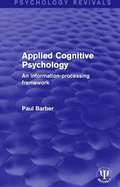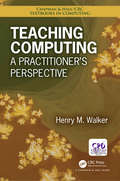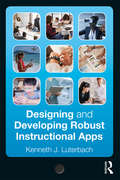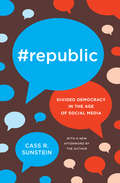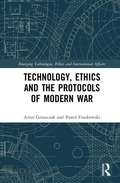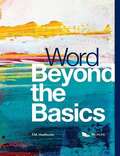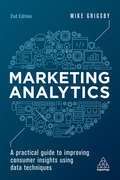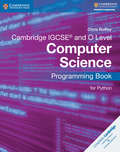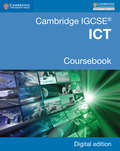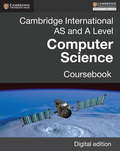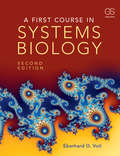- Table View
- List View
Applied Cognitive Psychology: An Information-processing Framework (PDF)
by Paul BarberOriginally published in 1988 Applied Cognitive Psychology draws on the psychology of perception, attention, and cognition to give an understanding of some everyday activities and skills. Paul Barber focuses on processes involved in selecting simple actions, face perception, reading, and tasks requiring attention skills. He uses practical problems as starting points for discussion, including mental overloading in air-traffic controllers, cooker-hob design, the use of Photokit/identikit, and reading from computer screens. The book also examines the strengths and limitations of the basic analytical approach of ‘information-processing’ in psychology. As well as providing a textbook for students of psychology and ergonomics, Applied Cognitive Psychology will still be welcomed by those from other disciplines – management studies, education, sports science – who need to understand skilled behaviour in applied settings.
Teaching Computing: A Practitioner's Perspective
by Henry M. WalkerTeaching can be intimidating for beginning faculty. Some graduate schools and some computing faculty provide guidance and mentoring, but many do not. Often, a new faculty member is assigned to teach a course, with little guidance, input, or feedback. Teaching Computing: A Practitioner’s Perspective addresses such challenges by providing a solid resource for both new and experienced computing faculty. The book serves as a practical, easy-to-use resource, covering a wide range of topics in a collection of focused down-to-earth chapters. Based on the authors’ extensive teaching experience and his teaching-oriented columns that span 20 years, and informed by computing-education research, the book provides numerous elements that are designed to connect with teaching practitioners, including: A wide range of teaching topics and basic elements of teaching, including tips and techniques Practical tone; the book serves as a down-to-earth practitioners’ guide Short, focused chapters Coherent and convenient organization Mix of general educational perspectives and computing-specific elements Connections between teaching in general and teaching computing Both historical and contemporary perspectives This book presents practical approaches, tips, and techniques that provide a strong starting place for new computing faculty and perspectives for reflection by seasoned faculty wishing to freshen their own teaching.
Teaching Computing: A Practitioner's Perspective
by Henry M. WalkerTeaching can be intimidating for beginning faculty. Some graduate schools and some computing faculty provide guidance and mentoring, but many do not. Often, a new faculty member is assigned to teach a course, with little guidance, input, or feedback. Teaching Computing: A Practitioner’s Perspective addresses such challenges by providing a solid resource for both new and experienced computing faculty. The book serves as a practical, easy-to-use resource, covering a wide range of topics in a collection of focused down-to-earth chapters. Based on the authors’ extensive teaching experience and his teaching-oriented columns that span 20 years, and informed by computing-education research, the book provides numerous elements that are designed to connect with teaching practitioners, including: A wide range of teaching topics and basic elements of teaching, including tips and techniques Practical tone; the book serves as a down-to-earth practitioners’ guide Short, focused chapters Coherent and convenient organization Mix of general educational perspectives and computing-specific elements Connections between teaching in general and teaching computing Both historical and contemporary perspectives This book presents practical approaches, tips, and techniques that provide a strong starting place for new computing faculty and perspectives for reflection by seasoned faculty wishing to freshen their own teaching.
Artificial Intelligence and Expert Systems for Engineers (New Directions in Civil Engineering #11)
by C. S. Krishnamoorthy S. RajeevThis book provides a comprehensive presentation of artificial intelligence (AI) methodologies and tools valuable for solving a wide spectrum of engineering problems. What's more, it offers these AI tools on an accompanying disk with easy-to-use software. Artificial Intelligence and Expert Systems for Engineers details the AI-based methodologies known as: Knowledge-Based Expert Systems (KBES); Design Synthesis; Design Critiquing; and Case-Based Reasoning. KBES are the most popular AI-based tools and have been successfully applied to planning, diagnosis, classification, monitoring, and design problems. Case studies are provided with problems in engineering design for better understanding of the problem-solving models using the four methodologies in an integrated software environment.Throughout the book, examples are given so that students and engineers can acquire skills in the use of AI-based methodologies for application to practical problems ranging from diagnosis to planning, design, and construction and manufacturing in various disciplines of engineering.Artificial Intelligence and Expert Systems for Engineers is a must-have reference for students, teachers, research scholars, and professionals working in the area of civil engineering design in particular and engineering design in general.
Designing and Developing Robust Instructional Apps
by Kenneth J. LuterbachDesigning and Developing Robust Instructional Apps advances the state of instructional app development using three learning paradigms for building knowledge foundations, problem-solving, and experimentation. Drawing on research and development lessons gleaned?from noted educational technologists, time-tested systematic instructional design processes, and results from user experience design, the book considers the planning and specification of instructional apps that blend media (text, images, sound, and moving pictures) and instructional method. Further, for readers with little to no programming experience, introductory treatments of JavaScript and Python, along with data fundamentals and machine learning techniques, offer a guided journey that produces robust instructional apps and?concludes with next steps for advancing the state of instructional app development.
Artificial Intelligence: With an Introduction to Machine Learning, Second Edition (Chapman & Hall/CRC Artificial Intelligence and Robotics Series)
by Richard E. Neapolitan Xia JiangThe first edition of this popular textbook, Contemporary Artificial Intelligence, provided an accessible and student friendly introduction to AI. This fully revised and expanded update, Artificial Intelligence: With an Introduction to Machine Learning, Second Edition, retains the same accessibility and problem-solving approach, while providing new material and methods. The book is divided into five sections that focus on the most useful techniques that have emerged from AI. The first section of the book covers logic-based methods, while the second section focuses on probability-based methods. Emergent intelligence is featured in the third section and explores evolutionary computation and methods based on swarm intelligence. The newest section comes next and provides a detailed overview of neural networks and deep learning. The final section of the book focuses on natural language understanding. Suitable for undergraduate and beginning graduate students, this class-tested textbook provides students and other readers with key AI methods and algorithms for solving challenging problems involving systems that behave intelligently in specialized domains such as medical and software diagnostics, financial decision making, speech and text recognition, genetic analysis, and more.
Artificial Intelligence: With an Introduction to Machine Learning, Second Edition (Chapman & Hall/CRC Artificial Intelligence and Robotics Series)
by Richard E. Neapolitan Xia JiangThe first edition of this popular textbook, Contemporary Artificial Intelligence, provided an accessible and student friendly introduction to AI. This fully revised and expanded update, Artificial Intelligence: With an Introduction to Machine Learning, Second Edition, retains the same accessibility and problem-solving approach, while providing new material and methods. The book is divided into five sections that focus on the most useful techniques that have emerged from AI. The first section of the book covers logic-based methods, while the second section focuses on probability-based methods. Emergent intelligence is featured in the third section and explores evolutionary computation and methods based on swarm intelligence. The newest section comes next and provides a detailed overview of neural networks and deep learning. The final section of the book focuses on natural language understanding. Suitable for undergraduate and beginning graduate students, this class-tested textbook provides students and other readers with key AI methods and algorithms for solving challenging problems involving systems that behave intelligently in specialized domains such as medical and software diagnostics, financial decision making, speech and text recognition, genetic analysis, and more.
#Republic: Divided Democracy in the Age of Social Media
by Cass R. SunsteinFrom the New York Times bestselling author of Nudge and The World According to Star Wars, a revealing account of how today's Internet threatens democracy—and what can be done about itAs the Internet grows more sophisticated, it is creating new threats to democracy. Social media companies such as Facebook can sort us ever more efficiently into groups of the like-minded, creating echo chambers that amplify our views. It's no accident that on some occasions, people of different political views cannot even understand one another. It's also no surprise that terrorist groups have been able to exploit social media to deadly effect. Welcome to the age of #Republic.In this revealing book, New York Times bestselling author Cass Sunstein shows how today’s Internet is driving political fragmentation, polarization, and even extremism--and what can be done about it. He proposes practical and legal changes to make the Internet friendlier to democratic deliberation, showing that #Republic need not be an ironic term. Rather, it can be a rallying cry for the kind of democracy that citizens of diverse societies need most.
#Republic: Divided Democracy in the Age of Social Media
by Cass R. SunsteinFrom the New York Times bestselling author of Nudge and The World According to Star Wars, a revealing account of how today's Internet threatens democracy—and what can be done about itAs the Internet grows more sophisticated, it is creating new threats to democracy. Social media companies such as Facebook can sort us ever more efficiently into groups of the like-minded, creating echo chambers that amplify our views. It's no accident that on some occasions, people of different political views cannot even understand one another. It's also no surprise that terrorist groups have been able to exploit social media to deadly effect. Welcome to the age of #Republic.In this revealing book, New York Times bestselling author Cass Sunstein shows how today’s Internet is driving political fragmentation, polarization, and even extremism--and what can be done about it. He proposes practical and legal changes to make the Internet friendlier to democratic deliberation, showing that #Republic need not be an ironic term. Rather, it can be a rallying cry for the kind of democracy that citizens of diverse societies need most.
Education Policy and the Australian Education Union: Resisting Social Neoliberalism and Audit Technologies
by Andrew VandenbergThis book focuses on the politics of teacher resistance to the formation and implementation of neoliberal education policies in Australia. It argues that policies such as publishing examination test results online amounts to auditing teachers’ work, and assumes incompetence from teachers, which ultimately results in diverting teachers from their true professional responsibilities. The book outlines the rise of transnational networks that promote market-oriented methods of achieving social objectives, such as good education for all students, and considers a range of explanations for why this education policy was strengthened in Australia in 2010. It also reviews a range of arguments about professional unionism, and reflects on the history of the Australian Education Union and its capacity to resist social neoliberalism. The book concludes by reporting on a case-study in which principals, teachers and parents at two ordinary schools in Australia have managed to keep market forces at bay. It will appeal to students and researchers in the fields of education and sociology, particularly those interested in education policy, political ideology, unionism, and schools.
Education Policy and the Australian Education Union: Resisting Social Neoliberalism and Audit Technologies
by Andrew VandenbergThis book focuses on the politics of teacher resistance to the formation and implementation of neoliberal education policies in Australia. It argues that policies such as publishing examination test results online amounts to auditing teachers’ work, and assumes incompetence from teachers, which ultimately results in diverting teachers from their true professional responsibilities. The book outlines the rise of transnational networks that promote market-oriented methods of achieving social objectives, such as good education for all students, and considers a range of explanations for why this education policy was strengthened in Australia in 2010. It also reviews a range of arguments about professional unionism, and reflects on the history of the Australian Education Union and its capacity to resist social neoliberalism. The book concludes by reporting on a case-study in which principals, teachers and parents at two ordinary schools in Australia have managed to keep market forces at bay. It will appeal to students and researchers in the fields of education and sociology, particularly those interested in education policy, political ideology, unionism, and schools.
Technology, Ethics And The Protocols Of Modern War (PDF)
by Artur Gruszczak Pawel FrankowskiContemporary security has expanded its meaning, content and structure in response to globalisation and the emergence of greatly improved world-wide communication. The protocols of modern warfare, including targeted killing, enhanced interrogations, mass electronic surveillance and the virtualisation of war have changed the moral landscape and brought diverse new interactions with politics, law, religion, ethics and technology. This book addresses how and why the nature of security has changed and what this means for the security actors involved and the wider society. Offering a crossdisciplinary perspective on concepts, meanings and categories of security, the book brings together scholars and experts from a range of disciplines including political, military studies and security studies, political economy and international relations. Contributors reflect upon new communication methods, postmodern concepts of warfare, technological determinants and cultural preferences to provide new theoretical and analytical insights into a changing security environment and the protocols of war in the 21st century. A useful text for scholars and students of security studies, international relations, global governance, international law and ethics, foreign policy, comparative studies and contemporary world history.
Word Beyond the Basics (PDF)
by Pm HeathcoteMS Word is one of the most useful applications for anyone who uses a computer in their studies, at work or at home. However, a great many people have never been taught the best or most efficient way of performing simple tasks like creating a neat list in columns, placing images exactly where they want them or quickly changing text styles throughout a document. Additionally, many users struggle to adapt to newer versions of Word, and need help learning the best ways of doing familiar tasks or using new facilities introduced in Word 2013 and subsequent versions. This book assumes that you know the basics of how to create and edit a simple document, and shows you how to do much, much more. The mysteries of the tabs and ribbon interface used in Word 2013 and Word 2016 are laid bare and you will soon find you can do all you wanted and more in a fraction of the time it took before. It really is all very simple once it’s explained!
The SAGE Handbook of E-learning Research (PDF)
by Eric M. Meyers Jude Fransman Professor Caroline Haythornthwaite Mr Richard N. L. AndrewsThe new edition of The SAGE Handbook of E-Learning Research retains the original effort of the first edition by focusing on research while capturing the leading edge of e-learning development and practice. Chapters focus on areas of development in e-learning technology, theory, practice, pedagogy and method of analysis. Covering the full extent of e-learning can be a challenge as developments and new features appear daily. The editors of this book meet this challenge by including contributions from leading researchers in areas that have gained a sufficient critical mass to provide reliable results and practices. The 25 chapters are organised into six key areas: 1. THEORY 2. LITERACY & LEARNING 3. METHODS & PERSPECTIVES 4. PEDAGOGY & PRACTICE 5. BEYOND THE CLASSROOM 6. FUTURES
Data-Driven HR: How to Use Analytics and Metrics to Drive Performance
by Bernard MarrTraditionally seen as a purely people function unconcerned with numbers, HR is now uniquely placed to use company data to drive performance, both of the people in the organization and the organization as a whole. Data-Driven HR is a practical guide which enables HR professionals to leverage the value of the vast amount of data available at their fingertips. Covering how to identify the most useful sources of data, collect information in a transparent way that is in line with data protection requirements and turn this data into tangible insights, this book marks a turning point for the HR profession. Covering all the key elements of HR including recruitment, employee engagement, performance management, wellbeing and training, Data-Driven HR examines the ways data can contribute to organizational success by, among other things, optimizing processes, driving performance and improving HR decision making. Packed with case studies and real-life examples, this is essential reading for all HR professionals looking to make a measurable difference in their organizations.
Data-Driven HR: How to Use Analytics and Metrics to Drive Performance
by Bernard MarrTraditionally seen as a purely people function unconcerned with numbers, HR is now uniquely placed to use company data to drive performance, both of the people in the organization and the organization as a whole. Data-Driven HR is a practical guide which enables HR professionals to leverage the value of the vast amount of data available at their fingertips. Covering how to identify the most useful sources of data, collect information in a transparent way that is in line with data protection requirements and turn this data into tangible insights, this book marks a turning point for the HR profession. Covering all the key elements of HR including recruitment, employee engagement, performance management, wellbeing and training, Data-Driven HR examines the ways data can contribute to organizational success by, among other things, optimizing processes, driving performance and improving HR decision making. Packed with case studies and real-life examples, this is essential reading for all HR professionals looking to make a measurable difference in their organizations.
Marketing Analytics: A Practical Guide to Improving Consumer Insights Using Data Techniques
by Mike GrigsbyWho is most likely to buy and what is the best way to target them? How can businesses improve strategy without identifying the key influencing factors? The second edition of Marketing Analytics enables marketers and business analysts to leverage predictive techniques to measure and improve performance. By exploring real-world marketing challenges, it provides clear, jargon-free explanations on how to apply different analytical models for each purpose. From targeted list creation and data segmentation, to testing campaign effectiveness, pricing structures and forecasting demand, this book offers a welcome handbook on how statistics, consumer analytics and modelling can be put to optimal use. The fully revised second edition of Marketing Analytics includes three new chapters on big data analytics, insights and panel regression, including how to collect, separate and analyze big data. All of the advanced tools and techniques for predictive analytics have been updated, translating models such as tobit analysis for customer lifetime value into everyday use. Whether an experienced practitioner or having no prior knowledge, methodologies are simplified to ensure the more complex aspects of data and analytics are fully accessible for any level of application. Complete with downloadable data sets and test bank resources, this book supplies a concrete foundation to optimize marketing analytics for day-to-day business advantage.
Marketing Analytics: A Practical Guide to Improving Consumer Insights Using Data Techniques (Marketing Science Ser.)
by Mike GrigsbyWho is most likely to buy and what is the best way to target them? How can businesses improve strategy without identifying the key influencing factors? The second edition of Marketing Analytics enables marketers and business analysts to leverage predictive techniques to measure and improve performance. By exploring real-world marketing challenges, it provides clear, jargon-free explanations on how to apply different analytical models for each purpose. From targeted list creation and data segmentation, to testing campaign effectiveness, pricing structures and forecasting demand, this book offers a welcome handbook on how statistics, consumer analytics and modelling can be put to optimal use. The fully revised second edition of Marketing Analytics includes three new chapters on big data analytics, insights and panel regression, including how to collect, separate and analyze big data. All of the advanced tools and techniques for predictive analytics have been updated, translating models such as tobit analysis for customer lifetime value into everyday use. Whether an experienced practitioner or having no prior knowledge, methodologies are simplified to ensure the more complex aspects of data and analytics are fully accessible for any level of application. Complete with downloadable data sets and test bank resources, this book supplies a concrete foundation to optimize marketing analytics for day-to-day business advantage.
Cambridge International AS and A Level IT Digital Edition
by Paul Long Sarah Lawrey Victoria EllisThis set of resources provides support for teachers and students of the Cambridge International AS and A Level Information Technology syllabus (9626). This Digital edition of Cambridge International AS and A Level IT Coursebook provides a clear and comprehensive guide to assist students as they develop theoretical and practical IT skills. It contains detailed explanations of theoretical and practical concepts and tasks, with worked examples and exercises to consolidate knowledge. Practical tasks are offered throughout the book to help students build and develop their practical knowledge. Content from the CD-ROM that accompanies the print coursebook is not included in this Digital edition.
Cambridge IGCSE® and O Level Computer Science Digital Edition (Cambridge International IGCSE)
by Chris RoffeyThis resource is written to follow the updated Cambridge IGCSE® Computer Science syllabus 0478 with examination from June and November 2016. This Digital edition of Cambridge IGCSE® and O Level Computer Science Programming Book for Python accompanies the Cambridge IGCSE and O Level Computer Science coursebook and is for students and teachers wishing to use Python in their studies. It introduces and develops practical skills, guiding students as they develop coding solutions to the tasks presented in the resource. Starting from simple skills and progressing to more complex challenges, this resource shows how to approach a coding problem using Structure Diagrams and Flow Charts, explains programming logic using pseudocode, develops Python programming skills and gives full solutions to the tasks set.
Cambridge IGCSE® ICT Coursebook Digital Edition (Cambridge International IGCSE)
by Victoria Wright Denise TaylorThis comprehensive resource is written to cover the Cambridge IGCSE ICT syllabus (0417). This Digital edition of Cambridge IGCSE ICT Second edition provides a complete course for developing and practising the skills required for students of the IGCSE ICT syllabus (0417). It contains detailed explanations of concepts, worked examples and exercises to consolidate knowledge.
Cambridge International AS and A Level Computer Science Coursebook Digital edition
by Sylvia Langfield Dave DuddellCambridge International AS and A Level Computer Science offers a complete set of resources to accompany the 9608 syllabus. This Digital edition of the Cambridge International AS and A Level Computer Science coursebook delivers an accessible guide to theoretical and practical skills in computer science, with a clear progression of tasks that help to consolidate and develop knowledge. It offers students detailed descriptions of the concepts, reinforced with examples that outline complex subject matter in a clear way. Alongside fundamental definitions, higher level programming skills are developed through the explanation of processes and consolidated by practical exam-type questions for students to attempt.
Cambridge IGCSE® Computer Science Coursebook Digital Edition (Cambridge International IGCSE)
by Sarah Lawrey Donald ScottThis resource is written to follow the updated Cambridge IGCSE® Computer Science syllabus 0478 with examination from June and November 2016. This Cambridge IGCSE® Computer Science Digital edition is designed to provide up to date and comprehensive material to cover recent developments in computer science. The content has been written by experienced IGCSE teachers and computer science trainers, offering readers support on the theoretical and practical aspects of the course. It contains detailed explanations of concepts, with examples and tasks to help students consolidate their skills.
Cambridge IGCSE® Computer Science Programming Book Digital edition: for Microsoft® Visual Basic (Cambridge International IGCSE)
by Richard MorganThis resource is written to follow the updated Cambridge IGCSE® Computer Science syllabus 0478 with examination from June and November 2016. This Digital edition of the Cambridge IGCSE® Computer Science Programming Book for Microsoft® Visual Basic introduces and develops the practical skills that will help readers to develop coding solutions to the tasks contained within. Starting from simple skills to more complex challenges, this book shows how to approach a coding problem using Structure Diagrams and Flow Charts, explains programming logic using pseudocode, and gives full solutions to the programming tasks set.
A First Course in Systems Biology
by Eberhard VoitA First Course in Systems Biology is an introduction for advanced undergraduate and graduate students to the growing field of systems biology. Its main focus is the development of computational models and their applications to diverse biological systems. The book begins with the fundamentals of modeling, then reviews features of the molecular inventories that bring biological systems to life and discusses case studies that represent some of the frontiers in systems biology and synthetic biology. In this way, it provides the reader with a comprehensive background and access to methods for executing standard systems biology tasks, understanding the modern literature, and launching into specialized courses or projects that address biological questions using theoretical and computational means. New topics in this edition include: default modules for model design, limit cycles and chaos, parameter estimation in Excel, model representations of gene regulation through transcription factors, derivation of the Michaelis-Menten rate law from the original conceptual model, different types of inhibition, hysteresis, a model of differentiation, system adaptation to persistent signals, nonlinear nullclines, PBPK models, and elementary modes. The format is a combination of instructional text and references to primary literature, complemented by sets of small-scale exercises that enable hands-on experience, and large-scale, often open-ended questions for further reflection.
